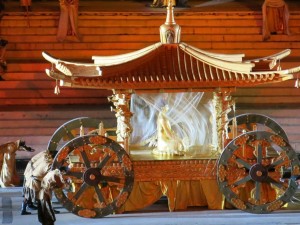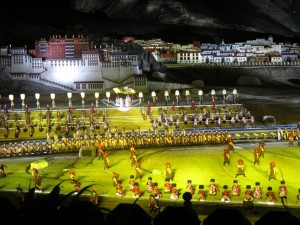Source: Washington Post (10/11/16)
In Tibet, History bows down before propaganda in the tale of a royal romance
By Simon Denyer
It is an epic tale of love between a teenage princess and a noble emperor, of the first bonds of friendship between China and Tibet that sprung up more than 15 centuries ago. It is a tale of how China brought civilization to its barbarous west, rendered in lavish operatic form.
But this is more than an operatic romanticization of ancient history, it is a deliberate attempt, experts say, to rewrite history in the service of propaganda.
The story of Princess Wencheng Gongzhu and her marriage to Tibetan Emperor Songsten Gampo is the subject of a multimillion dollar opera that plays most nights for tourists in the Tibetan capital Lhasa. Choreographed by the famous Chinese film director Zhang Yimou, who also directed the Beijing Olympics’ opening and closing ceremonies, it plays out under the stars on a vast stage, with a cast of hundreds and a vast replica of the Potala Palace.

An actress plays Princess Wencheng during an operatic re-enactment of her romance with Tibetan Emperor Songsten Gampo in Lhasa, China. (Simon Denyer/The Washington Post).
But this is more legend than history, and more propaganda than legend.
Historians say the tale of Princess Wencheng has been twisted by Communist China to justify its 1951 occupation — or “liberation” of Tibet.
Here’s the story in a nutshell — with a few quotes from the opera.
The Tang dynasty Emperor of China offers one of his teenage daughters to Songsten Gampo to return for an agreement not to raid the Chinese borderlands, a relatively common practice known as a “peace-marriage.” With her, he sends treasures “that shine like a sky full of stars,” as well as an important statue of Buddha.

A statue of Buddha is transported from China to Tibet during an operatic reenactment of the romance between Princess Wencheng and Songtsen Gampo in Lhasa. (Simon Denyer/The Washington Post)
At first, as she travels through the “western wilderness,” Wencheng misses the “elegant ceremonies, the music and the classic books” she left behind in China.
Ultimately, though, she falls in love with the Tibetan emperor, a man who dreams of freeing the poor and turning his land into paradise on earth.
In this version, Songsten Gampo is cast as the noble savage, experts say, or even perhaps a proto-communist.
In honor of the princess, the Tibetan emperor builds the Potala Palace, metaphorically casting Tibet’s most famous landmark as a tribute to Chinese love.
Although not explicitly mentioned in the opera, other modern Chinese accounts allege that Wencheng also brought civilization to Tibet, in form of medical knowledge, highland barley and even Buddhism.
This is a version of history commissioned and shaped by Chinese Premier Zhou Enlai, according to Aarhus University associate professor Cameron David Warner.
Zhou commissioned Communist playwright and composer Tian Han (who also penned the national anthem of the People’s Republic) to write a play about the life of the princess in the wake of a Tibetan uprising in 1959 and subsequent repression.
The idea: “to emphasize Wencheng as a symbol of a long friendship between unequal partners — Tibetans dependent upon China for economic and technological development,” Warner wrote.
It is, in other words, a justification for China’s “liberation” of Tibet from feudal serfdom, and an attempt to cast Beijing as the benevolent elder brother.
It is a version that has since become the subject of television soap operas, books and DVDs — and now a mammoth opera that has become an integral part of a Chinese tour of Tibet.
“This is a vast project that rewrites history and ‘wipes out’ the memory and culture of an entire people,” complains Tibetan writer and activist Woeser. “They can brainwash people and make money at the same time.”
In Tibetan memory, there several other versions of the story. Some do indeed cast Wencheng as an important figure in the history of Tibetan Buddhism, alongside another of the emperor’s foreign wives, the Nepali Princess Bhrikuti Devi. Yet both are very much secondary figures to the benevolent emperor, Songsten Gampo himself.
Another, quite distinct tradition emerges from eastern Tibet, from the regions once known as Kham and Amdo that are now largely subsumed into the Chinese provinces of Qinghai and Sichuan.
In villages and towns across this part of the world, Wencheng is remembered as having stopped during her epic years-long journey from Beijing to Lhasa. During the journey, so legend has it, she indeed fell in love with a Tibetan — but not the emperor: instead, it was his emissary Gar Tongtsen with whom she was romantically entwined, and with whom she bore an illegitimate child.
She either miscarried or the baby died shortly after birth, and several shrines or stupas across eastern Tibet claim to contain its remains. Some even claim to have the statue of Buddha she brought with it, alleging that the version still on display in Lhasa’s Jokhang Temple is a replica.
There is even a Tibetan lama who claims to be the reincarnation of that baby: he now lives in San Diego.
So what do the history books tell us?
P. Christiaan Klieger, a cultural anthropologist and historian, says contemporary Tibetan annals do not even mention the existence of Princess Wencheng, or of the emperor’s Nepali bride, who both emerge in Tibetan and Chinese histories centuries later. Instead they talk of the emperor’s principle wife as being a Tibetan queen.
“There isn’t really much evidence Princess Wencheng even existed,” he argues. “The king probably had several wives and some probably were married to cement alliances. But as you might imagine, Tibetan chronicles promote his Tibetan queen as a major person in the king’s life. She had a very powerful position and role in Tibetan society during their reign.”
The tale of Princess Wencheng, he says, is essentially a work of fiction.
China says Tibet has been part of its territory since the mid-13th century, while the Communist Party has governed the Himalayan region since 1951. But many Tibetans say that they were effectively independent for most of their history, and complain that the Chinese government wants to exploit their resource-rich region while crushing their cultural identity.
Tibetan writer Woeser sees the story of Princess Wencheng as part of a deeper pattern, where tourists from China’s majority Han ethnic group are presented with a whitewashed view of Tibetan history and its relationship to China — delivered by travel guides who are trained and loyal party members.
“So it is also very hard for tourists to understand and sympathize with Tibetans,” she said in an interview. “Information and history are reinvented to make Tibet look like it has belonged to China for a long time, and make China look powerful in its influence as a savior for Tibet.”
That, she says, makes it unlikely that tourists, now entering Tibet in record numbers, will ever penetrate to the core of Tibetan’s lives, culture and religious beliefs, or understand their concerns.
Congcong Zhang contributed to this report.
